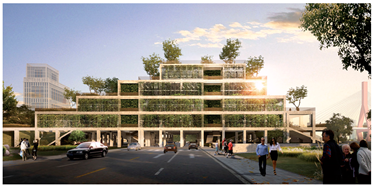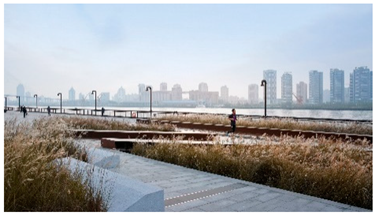Abstract
Urban waterfronts in port cities have experienced a dramatic shift in the process of expanding industrialization, which causes severe ecological and social problems in postindustrial cities. Transforming manufacturing sites to inclusive landscapes requires costly remediation and careful planning to foster smart development that promotes the city’s economic vibrancy, enhances social and cultural contexts, and improves quality of life. While conventional reclamation strategies mainly focus on the technical aspect of simply performing to meet minimum engineering standards, new industrial urbanism offers a pathway to relink the manufacturing waterfront in contemporary city life through ‘landscape medium’. This paper explores the evolutionary phases of industrial waterfronts from a diachronic perspective and proposes a theoretical framework that utilizes the landscape medium to integrate historically separated elements, including people, infrastructure, and buildings. Using the Yangpu waterfront in Shanghai as a case study, we analyze a completed reclamation project and summarize four sustainable design approaches—connecting, resilient, locality, and inclusive—that can transform obsolete manufacturing sites into inclusive urban landscapes. The primary contribution of this regeneration plan is to reconstruct a continuous and adaptable waterfront field that can accommodate diverse activities and changing needs. To validate our urban design framework, we examine another industrial waterfront renewal project along the Soochow Creek, which has been successfully approved in conceptual design. Overall, our research demonstrates the potential for sustainable, inclusive, and adaptable urban design to revitalize industrial waterfronts and create vibrant, livable urban landscapes.
1. Introduction: Industrial Waterfronts
The proximity of human settlements to water bodies has been a common occurrence throughout history [1]. Many glorious cities across the world are situated by rivers, lakes, or seas, such as the Thames River for London, the Seine River for Paris, and the West Lake for Hangzhou. In ancient times, water symbolized nature, which nourished and maintained human life, whereas land was the symbol of urban civilization [2]. Consequently, land and water areas have been regarded as the most fertile and vibrant places, epitomizing the harmony between humans and nature.
During the era of industrialization, the urban waterfront evolved into a hub for production circulation, particularly for port cities. The waterfront area underwent significant growth, transforming into a prosperous location where various manufacturing factors, such as industry, economy, and manpower, converged [3]. As a typical example, the mutual symbiosis between the Huangpu River and Shanghai showed the general urban development process during industrialization. Two important points emerge from this. First, the opening of the port in the 1840s led to the rapid expansion of urban space around the Huangpu River in Shanghai; in virtue of this, the riverfront area extended accordingly. Secondly, given the geographical advantages that the urban inland lacked, the waterfront alone soon became a resource frontier for various sorts of factories.
In the postindustrialization period, there was a fundamental shift in the economic structure from a manufacturing-based economy that relied on commodity capital to a service economy driven by innovative industries [4]. This change highlighted the urgent need for industrial transformation in developing countries [5]; as a result, the majority of factories were forced to relocate out of the inner city. The affiliated waterfronts that boomed during the industrial period simply lack the ability to adapt to the current social and economic needs of the postindustrial city as a whole [6]; they may end up becoming vacant or deserted for being out of use. Alan Berger termed this type of place as ‘drosscape’, meaning ‘useless things’ or ‘waste’, which needs retrofitting in the postindustrial age [7]. The Yangpu section of the Huangpu riverside has been the most industrialized section since Shanghai opened its port, carrying a large number of drosscapes left by the industrialization process.
As used to describe economics-driven frameworks throughout the urban physical environment, the concept of ‘industrial urbanism’ originated from the work of Tali Hatuka and Eran Ben-Joseph, who employed the concept to illustrate the evolving relationships between cities and places of production [8]. According to these evolving notions, we can apply the changing paradigm to urban industrial waterfronts throughout history, which divides the whole process into four phases (Figure 1). The first phase lasted for many centuries, when human productivity was largely constrained by hand tools, and people maintained a harmonious balance with nature. This phase was interrupted by modernization, coupled with rapid industrialization, which transformed traditional rural settlements into large industrial cities and the wetlands into manufacturing wharfs. As the profitability of traditional manufacturing diminished for the period ahead into advanced industrialization, most plants within cities were relocated to the outskirts, leaving the industrial waterfront in an abandoned state. With our current focus on environmentally sustainable development, the patchwork of discrete brownfield lands should be rehabilitated and integrated into high-quality urban places [9].

Figure 1.
Evolving paradigms of urban waterfronts.
New industrial urbanism is concerned with the spatial implications and physical design aspect of integrating manufacturing sites into contemporary cities, which provides a broad-level perspective for understanding the changing process of industrial waterfront, and therefore making design strategies initiated in response to contemporary dynamics. Unlike the drastic ‘clean-sweep’ redevelopment path that rejects the past and rebuilds sites from scratch [10], industrial urbanism emphasizes the preservation of industrial heritages, such as old warehouses, infrastructure, decks, and collective memory of the site [11]. From this viewpoint, the key to developing industrial areas is ‘reinvention’, which involves the regeneration of traditional industrial sites and integrating them into modern cities for both economic and aesthetic reasons. Complex though this regeneration program would be, physical planning and environmental design can play a crucial role in fostering more active involvement and promising a sustainable and inclusive vision for the urban future [12]. This research analyzes the design strategy employed in the urban regeneration of the Shanghai Yangpu riverfront, which offers a case study for transforming an abandoned industrial site into an inclusive urban landscape. By examining this process, the research aims to set a paradigm for industrial site transformation that can be applied more widely.
2. Method: Landscape as a Medium for Industrial Urbanism
According to Waldheim (2002), many architects and urban planners view landscape as the model and medium through which contemporary urbanism can be best understood [13]. In China’s rapid urbanization, planners determine the holistic structure of the city, architects design and construct buildings, and landscape designers provide landscape schemes accordingly. However, while landscape designers may consider the overall picture, they often limit their scope to physical elements such as plants, stones, and pavements, and hence ignore or overlook the cultural and social environment in which people live [14]. As a result, landscape urbanism calls for a more unified mechanism that breaks down the rigid discipline boundaries, no longer treating landscape as an object for ‘visual observation’ but as a ‘phenomenal setting’ derived from the site.
Given this, in the context of new industrial urbanism, the landscape provides a multifold medium for integrating various discrete elements in an industrial waterfront (Figure 2). A common understanding of the desired outcome can be achieved by planners and architects using landscape as a design concept before any specific physical design takes place, which dovetails with eco-friendly goals for sustainable futures. One of the primary advantages of the landscape is its potential to support a diverse range of activities, such as sports, festivals, demonstrations, fairs, concerts, and picnics, as well as unscripted, informal events, all of which can occur on an open field.
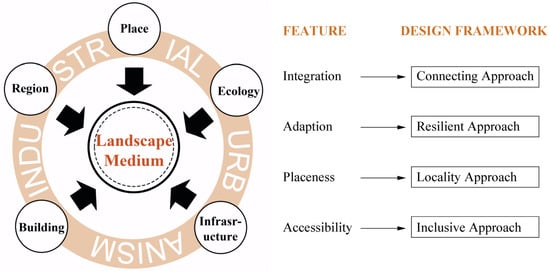
Figure 2.
Landscape as a medium for industrial urbanism.
Four significant features of the ‘landscape medium’ approach are worth highlighting. Firstly, the approach prioritizes integration, meaning that environmental elements of various scales or categories are harmoniously blended into a unified surface, creating a close relationship with the postindustrial place. The landscape, therefore, becomes a medium that connects infrastructure, buildings, and public places.
Secondly, the approach values adaption. Contemporary cities are full of economic, political, and social uncertainties, but the landscape, as a medium, can transform, adapt, and continue over time. This quality complements the geometric simplicity of modern architecture and always allows for a relatively open attitude to accommodate massive elements on the surface.
Secondly, the approach values placeness. As Kenneth Framptom noted, the remedial landscape better reflects ‘resistance’ than entity formalism, thereby reflecting the existing urban landscape’s strong topographical character [15]. Considering the close interaction between landscape and human perception, it becomes the most direct interpreter and presenter of the spirit of place.
Lastly, the approach underlines inclusiveness. While recent decades have brought about increasing focus on inclusive public space in neighborhoods and cities [16,17], ‘landscape medium’ offers an incremental solution to this issue. Landscapes change and evolve and could be easily shaped by force and resistance working overtime, so they would allow more accessibility for different economic parts or social groups and fewer boundaries to be set.
3. Yangpu Riverfront: Resurrection of Century-Old Industrial Site
Located in the northeast of Shanghai, the Yangpu district has a rich history as one of China’s most important industrial centers. Since the opening of Shanghai’s commercial port in the 1840s, the district has experienced rapid growth. In 1869, the concession Engineering Bureau constructed a road along Huangpu River from the Bund to the riverfront port, which was named Yangshupu Road. Over the next hundred years, Yangpu became the birthplace of various industries in modern China, including textile mills, waterworks, and power plants [18]. As a result, the Yangpu riverfront became a district separated by various industrial ownerships, forming strip-shaped independent land and a special urban texture along the river, building a separation wall between the Huangpu River and the urban living space (Figure 3).

Figure 3.
Site context information of Yangpu industrial riverfront.
With Shanghai stepping into the middle–later period of industrialization after the 1980s, many of the production factories in Yangpu were forced to close down and relocate due to pollution and urban expansion. Fortunately, the local government has registered and preserved most of the district’s industrial heritages. According to official statistics, 66 historical buildings, with a total construction area of 262,000 square meters, were proposed to be preserved along the south section of the Yangpu riverfront [19]. Nevertheless, the building shells, infrastructure, and the site as a whole have fallen into disuse and dilapidation through years of neglect (Figure 4).

Figure 4.
Dilapidated scenery through years of neglect.
After entering the second decade of the 21st century, aiming to achieve the vision of building Shanghai into an ‘outstanding global city’, the local government has worked with the municipal planning department to develop plans to connect the public space along the Huangpu River. This is in line with China’s spatial governance policy, ‘Dual Urban Repairs’, which involves ecological restoration and urban repair. The main concern is how plans and policies could be made and implemented to regenerate the waterfront district and improve the quality of public space.
For the Yangpu district, our on-site survey identified three primary requirements for urban design and landscape design. First, the plan should provide continuity for the entire linear waterfront space, allowing for a mixture of uses and activities rather than their separation. Second, the design theme should incorporate the tradition and memory of the manufacturing industry and seek to preserve or rediscover industrial heritage sites rather than create a new plan. Third, given the fact of collateral damage, such as the deterioration of water quality, environmental resilience needs to be taken into account, including water restoration, ecosystem rebuild, and landscape improvement.
To address these requirements, the design proposed the concept of ‘building an ecological and inclusive Yangpu riverside space with industrial heritage as the clue’. The design strategy involved limited intervention, low-impact development, reuse of industrial heritage, and restoration of the original landscape. The design integrates contemporary city life with century-old industrial heritage. In the analogy of literary and musical structure, the theme of the design is vividly named ‘Three strips in chord, Nine chapters in score’. The three strips are, respectively, composed of the industrial heritage exhibition strip for people to look at, the healthy vitality strip for people to pass through, and the original landscape strip for people to ramble along. The nine chapters refer to the nine sections of public space with different characteristics, based on the overall 5.5 km industrial sites in different original function types (Figure 5).

Figure 5.
Master plan of Yangpu riverfront reclamation.
From a systems theory perspective, the industrial waterfront could be viewed as a linear urban system. There is a coherent unity that distinguishes it from other urban areas; on another level, it is also a set or assemblage of scenarios that are connected, associated, or interdependent, each telling a different part of the whole story. Consider, for example, that a citizen can walk through the strip from beginning to end for the purpose of learning and feeling the century-old history of industrial development in Yangpu district. The waterfront’s built-up environment is boldly conceived as a complex fabric with a constant tone and is full of variations, bringing citizens the spatial imagination of urban history.
4. A Sustainable Urban Design Framework
In Manufactured Sites: Rethinking the Post-industrial Landscape, Michael Hough begins with the notion of the emerging efforts to address the legacy of contaminated and derelict lands that has been left by past industrial activity [20]. Furthermore, Nail Kirkwood terms those places as ‘manufactured sites’, emphasizing their ‘artificial’ nature. This concept raises two important issues about human activities. On the one hand, the sites left over are the product of the industrialization process, demonstrating human’s great power to conquer and reshape nature. On the other hand, the reconstruction of these places in the postindustrial era represents another kind of artificial intervention, embodying pioneering human efforts to turn decay into renewal. This transformation can be viewed as an adjustment of the relationship between humans and nature, involving an appropriate metabolic repairing process.
When regenerating old industrial sites, numerous factors, such as environmental, ecological, and social factors, must be considered. Although there may not be a universally applicable method adaptable to tackle all possible brownfield lands, specific design practices may serve as typical models for some types of waterfronts. Therefore, the following section outlines four design approaches or working paradigms for place reproduction in the Yangpu riverfront that can be generally applied to other linear industrial waterfronts in port cities.
4.1. Connecting Approach
In most cases, there exist multiple breaking points along industrial waterfronts resulting from the division of property rights. Some of these points cannot be easily linked by tearing down separating walls due to different elevation levels and the winding contour of flood control walls, creating discontinuities. The longest breakpoint in the Yangpu waterfront is located at the Yangshupu waterwork, which is still in operation today and has a history dating back to 1880, when the British founded the Shanghai Water Supply Company. By the mid-1930s, the plant had tripled in size, spreading to the boundary of Huangpu riverfront. The castle wall with delicate classical ornaments inevitably cut down the path alongside the river (Figure 6).

Figure 6.
Yangshupu waterwork and its wall alongside Huangpu River.
As the longest ‘breakpoint’ of the Yangpu riverside, Yangshupu waterwork poses a significant challenge for urban regeneration efforts, so the government chose it as an experiment site to spearhead the whole program. To ensure the safety of production facilities and preserve their historical appearance, the fundamental premise was not to demolish or move the plant wall. On that basis, the design set up a 535 m-long hydrophilic trestle outside the water plant, which floats along the river and connects the two ends of the breaking point (Figure 7). Along the way, some of the original berthing piers were retained and organically combined with the water outlet of the water plant.
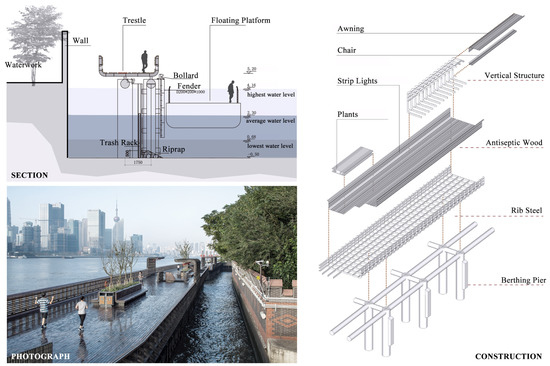
Figure 7.
Floating trestle for connecting breaking point.
The design team put forward a minimum-volume strategy for the trestle, obtained using structure simulations; it tends to reduce the construction material to the fullest extent. In advancing the effect of integration with the environment, antiseptic wood was adopted to fill the surface of the trestle. In addition, the boat-shaped structure combines the infrastructure with multiple functions, such as sun shade and green planting, providing rich and recreational space for citizens.
The connecting approach can be applied at a macro level, specifically in terms of the whole industrial waterfront. The Yangpu waterfront, which remains from previous industrialization, exhibits characteristics of fragmentation in its physical entity or spatial structure. There are numerous industrial enterprises and manufacturing foundations with a variety of categories, and the remaining buildings, facilities, and equipment are completely different, while the context has changed. The regeneration plan is instrumental in reconnecting the separate entities, and the appropriate method to achieve that objective is to incorporate industrial heritage exhibition, ecological appreciation space, and recreational activity trials into the landscape medium (Figure 8). Accordingly, as noted before, the entire industrial strip is divided into nine chapters. The design repurposes the sinking space of the dock to accommodate performance show stages and converts the old, abandoned factories into industrial museums. A number of wedge-shaped green spaces are renovated as ecological parks. Consequently, the public spaces after regeneration are closely connected to each other, providing ad hoc experiences. Although each space section is designed slightly differently in terms of visual or perception presentations, the overall strategy remains continuous and coordinated.

Figure 8.
Connecting approach to create sequential experiences.
More than 200 years ago, the French architect Claude-Nicolas Ledoux proposed the concept of ‘architecture parlante’ [21], aiming to explore the narrative and expressive capability of architecture itself. This argument can also be incorporated into industrial urbanism. Industrial landscapes often directly respond to or represent specific functions, which are naturally self-evident. Thus, the regeneration of the Yangpu industrial waterfront provides us with a working paradigm for dealing with manufactured sites, establishing connections, organizing sequences, and creating experiences.
4.2. Resilient Approach
The vast majority of industrial waterfronts are covered concrete surfaces, often contaminated to varying degrees, which presents a significant challenge for water-related environmental issues and redevelopment plans. Therefore, a resilient approach is proposed in the design proposal, which views the waterfront as a collection of interrelated ecosystems. The primary object is to establish a sustainable landscape or environmental framework for future development through a multidisciplinary approach, combining ecological recovery technology with proactive design strategies. In particular, ecological parks of various scales would be necessary and significant in the process of urban soil and water remediation. The resilience of these ecological solutions could be expediated by incorporating redundancy and environmental buffers, which means the low-impact design method can accommodate future disturbance to the regional ecosystem [22].
The regeneration of the Yangpu waterfront aims to create a sustainable green bank that can also serve the purpose of flood control. To this end, the flood control wall is set back from the bank line a certain distance (Figure 9), allowing for a more natural and eco-friendlier revetment to stem the flood. The natural revetment would efficiently deal with river floods and provide access to water-accessible activities for the public. Additionally, an environmental management system is proposed to improve the water and soil environment, along with a low-carbon strategy that includes ecological wetlands. These wetlands will promote the self-purification of habitats, conserve water, and neutralize harmful soil.
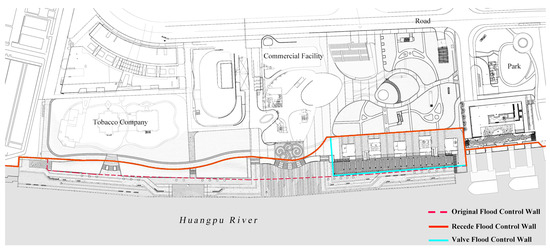
Figure 9.
Receding of flood control wall for natural banks.
The Rainwater Garden, created from the low-lying land of the Yihe textile mill, is currently the leading ecological repair project of the Yangpu waterfront. In Shanghai, the highest water level of the Huangpu River exceeds 4 m, while the site elevation in many areas is only about 3 m. Despite the construction of flood control projects on both sides of the Huangpu River meeting the standard of a 1000-year flood event, the annual heavy precipitation still causes waterlogging. In this context, building the Rainwater Garden can significantly delay the rapid collection of rainwater, effectively reducing the pressure in the urban drainage system and preventing waterlogging, in accordance with the fundamentally resilient requirement of the sponge city concept.
To achieve these goals, the design of the Rainwater Garden adopts the six technical measures of ‘seepage’, ‘storage’, ‘stagnation’, ‘purification’, ‘usage’, and ‘drainage’ of sponge cities. The Rainwater Garden’s seepage pavement, green space, and wetland occupy 90% of the site, absorbing rainwater to the soil and improving its quality. The second measure of storage utilizes the low-lying terrain to store water flexibly, reducing the risk of urban waterlogging and supporting the site’s greening. The third measure of stagnation collects rainwater in the Rainwater Garden and discharges it to the municipal pipe network after filling, thus greatly delaying the time of rainwater entering the urban pipe network and realizing the staggering peak of runoff. The fourth measure of purification employs aquatic plants to purify rainwater during soil infiltration. The fifth measure of usage establishes a system that pumps water from the rain garden to irrigate the green site, saving water usage. The sixth measure of drainage ensures rainwater slowly flows into the urban pipe network via an overflow port buried in the pebble belt at the edge of the Rainwater Garden.
The Rainwater Garden site underwent a long-term postevaluation of its ecological effect, which included scientific monitoring and quantification calculation (Figure 10). Microclimate data and comprehensive analyses of rainfall, runoff coefficient, seepage coefficient, rainstorm frequency, air temperature, humidity, and wind speed were collected to obtain a mathematical model of the dynamic balance of evaporation, catchment, and infiltration [23]. Preliminary results indicate significant improvement in the site’s ecological environment, including microclimate and water quality of the formerly industrial site.
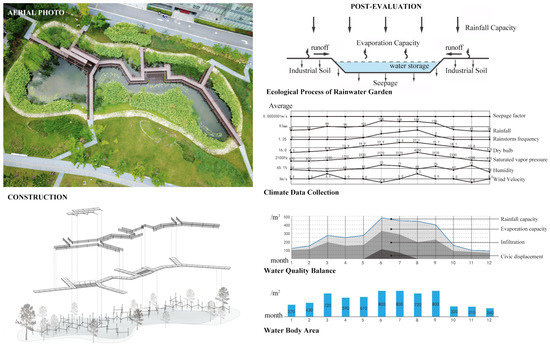
Figure 10.
Rainwater Garden (Yihe textile mill site).
4.3. Locality Approach
Every urban site encompasses both hard (tangible) and soft (intangible) values that contribute to human sustainable development. Genius loci is used to describe the intangible quality of a material place, perceived both physically and spiritually [24]. It is widely recognized that industrial memory forms an indispensable part of urban collective memory. In the postindustrial period, the landscape has become an important medium for realizing the continuity of context, being more flexible and artistic than buildings. However, how to design a landscape that represents the spirit of industrial memory in ways that differ from the postmodern architecture strategy remains unclear.
The regeneration design proposal for the Yangpu industrial waterfront raises the concept of ‘facing history and then being new’, which is in alignment with the restoration consensus among European scholars in the field of intangible cultural heritage protection since the 1950s [25]. Cesare Brandi, an eminent Italian art historian and theorist, defines restoration as ‘a methodological approach that focuses on inheriting artistic works so that they can be recognized as artistic works, in terms of material basis, aesthetics, and historical facts’ [26]. The site where industrial heritage is located can also be regarded as a certain work of art, which not only contains aesthetic value but also historical value based on factual evidence. Those two dimensions do not necessarily converge, while sometimes even contradicting each other. Therefore, Brandi proposed a critical restoration mechanism based on value judgment. The fundamental premise of regeneration design is to specify and weigh the value, both objective and subjective, of any industrial heritage element.
The mechanical treatment in the Yangpu waterfront project is not unified. Instead, the project assesses and evaluates the significance of various industrial heritages based on three dimensions, historical facts, aesthetics, and society, in order to establish an adaptive renewal system. Based on the value attributes, industrial heritage can be classified into three categories: industrial relic, industrial legacy, and industrial site. This trichotomy helps to gradually shift the restoration mode from protection to reconstruction, allowing for more flexible and innovative reuse modes (see Table 1). The regeneration of the Yangpu riverfront involves these three restoration strategies, all of which are integrated into the overall design of landscape medium, effectively capturing the characteristics of the spirit of the postindustrial era.

Table 1.
Three Categories of Restoration Mode in Yangpu Riverfront.
4.4. Inclusive Approach
In recent years, cultural and environmental scholars worldwide have reached a consensus on adopting a general policy to integrate the protection of industrial heritage into a comprehensive planning program that aims to give it a function in the community [27]. The People-Centered Approach (PCA) has become the key method for heritage protection and regeneration, as it emphasizes the importance of local participation in creating a sustainable urban environment [28]. Although the aesthetic perception of industrial sites is usually seen as sublime due to their estrangement from daily life, it is contrary to the people-centered idea of sharing, openness, and diversity in postindustrial sites. Therefore, the challenge for urban designers and landscape architects is to activate the vitality of the manufactured site through physical design, making people willing to enter the waterfront area that was once occupied by industrial facilities.
According to the research of Danish scholar Jan Gehl on the field of social public space, outdoor activities can be categorized into three types: necessary activities, spontaneous activities, and social activities [29]. The latter two types of activities usually occur in waterfront spaces. Spontaneous activities refer to those that people are willing to engage in, including walking, breathing fresh air, basking in the sun, and wandering to kill time, which will occur naturally as long as the external environment reaches the optimal standard. On the other hand, high-quality public space is determined by social activity, such as children’s games, conversations, and performances, which involves various interactive behaviors with others. The Yangpu riverfront has been a sought-after site in Shanghai, where groups of tourists and residents carry out a wide range of activities.
The key to integrating public participation into an industrial waterfront lies in the concept of ‘infrastructure architecture’. This means that industrial infrastructure should not be considered as something separate from the community, but rather should be designed to be more inclusive and integrated into daily life. In the case of the Yangpu waterfront, the previous industrial infrastructure, such as thick gates, flood control walls, and steel bollards, has been carefully designed and reassembled as public seating and other amenities, providing people with opportunities to engage in various activities. This has transformed the landscape from being purely visually appealing to providing a physical experience, thus stimulating the vitality of this postindustrial site.
The regeneration project of the Yangpu waterfront has achieved tremendous social, environmental, and economic benefits. The reclamation of the waterfront has triggered the redevelopment of the inner Yangpu district, which has seen the construction of nearly 100 major business projects, including 81 formal projects and 19 preparatory projects. Of the 81 formal projects, 26 are new, with a total construction area of more than 1.65 million square meters, and a total investment of about CNY 30 billion. A total of 15 projects have been completed, with a total construction area of about 526,000 m2. The creation of an inclusive waterfront public space is closely linked to the economical side, as it has prodigious engagement power and can attract people to the region, thus driving its vitality.
By and large, the innovation mechanism for recruiting enterprises in the Yangpu district is based on a sustainable redevelopment mode. The prior investment in the reclamation of the industrial waterfront is offset by the capital outlay to attract long-term business investment. In fact, little in the way of regeneration design would have been achieved in Yangpu district if community groups, small firms, and large financial institutions had not perceived that urban design proposals were very much in their interest.
5. Framework Application in Renewal Planning of Soochow Creek
Based on the experience with the Yangpu waterfront, we believe that the most effective method to transform industrial wharves to meet contemporary urban needs is to create a continuous landscape medium that fits within a sustainable urban design framework. The workflow has been successfully applied to another waterfront reclamation project, the Soochow Creek, which builds on its scientific base. Different from Huangpu River, the Soochow Creek has a much longer cultural history and humanities record as an important channel from the Taihu Lake basin to Shanghai. In ancient times, there was an assortment of settlements distributed on both sides of the creek, reflecting the typical landscape of a traditional water town. Due to Shanghai’s role as a trade port in the modern era, Soochow Creek became the main shipping route linking the interior region and Shanghai port, leading to the agglomeration of a multitude of warehouses and factories [30]. Unfortunately, due to a large amount of industrial sewage discharge, Soochow Creek became one of the earliest polluted rivers in China and paid a heavy price (Figure 11). As a result, Soochow Creek was damagingly polluted in the 1970s [31]. In 1996, several Chinese government agencies jointly launched the Soochow Creek Comprehensive Environmental Rehabilitation Project to improve the water quality and recover the river ecosystem. Despite the great achievement of the water treatment system, there are remaining challenges in the surrounding urban areas.

Figure 11.
Soochow Creek in the 1940s.
The study area for this planning project is primarily made up of uncoordinated, mixed-use, and undeveloped remnants of past industries, as well as dilapidated neighborhoods. With a total length of 13.2 km passing through 6 municipal governments, personalities of the river are going through substantial physical changes: from an industrial zone to various commercial and residential districts. Therefore, the renewal plan focuses more on the linkage between the waterfront and urban interior plots. We start with the assumption that we cannot afford to write off the profusion of the ecological, social, financial, and cultural context in the existing fabric alongside Soochow Creek. To achieve this goal, there is an urgent need to create a coordinated framework (i.e., landscape medium) within which these and other opportunities can be cultivated to ensure a sustainable pattern for development. The urban design framework based on the Yangpu experience was applied to the renewal proposal as follows.
5.1. Enhancing Pedestrian Network Connectivity
To enhance the connectivity between the waterfront space and hinterland in the highly dense urban area, a continuous pedestrian system adjacent to the river is crucial. Our proposed solution involves systematically linking significant public buildings, historical areas, green space, and subway stations through a compact walking network composed of streets, channels, and bridges. The most challenging issue in making this connectivity turned out to be the conflict between traffic and pedestrians. To address this issue, our planning approach creatively alleviates riverside motor vehicle traffic by implementing one-way traffic and relocating the newly released space to establish a continuous pathway for walking, jogging, and cycling (Figure 12). In addition, we seek to facilitate cross-river connectivity by constructing four pedestrian bridges.
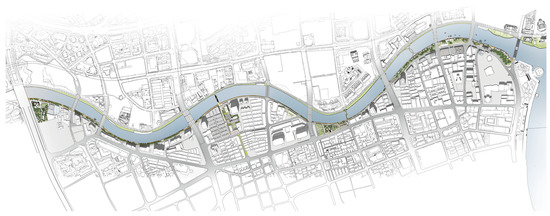
Figure 12.
Master plan of Soochow Creek renewal.
5.2. Creation of a Green Esplanade Alongside the River
The waterfront space beside Soochow Creek was very narrow and gloomy due to the flooding wall’s average height of over 5.2 m, which makes it difficult to see the river even from the bank. Just like the strategy adopted for the Yangpu waterfront, a similar approach is being used to address this issue, which is to lower the primary flood wall and then build the secondary retaining wall to ensure the flood control height (Figure 13). This creates an open green esplanade between the two walls, allowing the public to freely roam and relax along the entire waterfront. The ecological potential of Soochow Creek was thoroughly assessed, and the possibility of transforming it into a green landscape infrastructure was explored. In the area with a wide near-water space, stepped wetlands will be introduced to restore the original habitat, mitigate the impact of accidental floods, and provide opportunities for recreational activities. For areas with limited space, floating islands will be used to expand the wetland and Soochow Creek’s habitat. These islands will also enhance water quality by filtering nutrients, improving purification capacity, and providing underwater habitats for aquatic organisms. Overall, a variety of vertical shoreline forms will be created along the ecological waterfront.
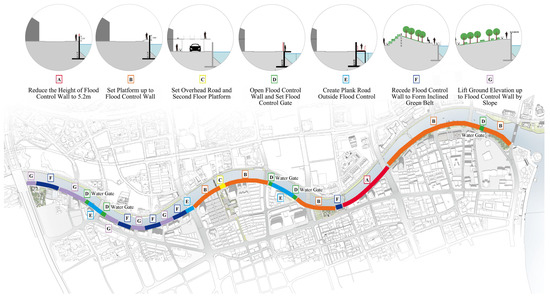
Figure 13.
Flood control wall retrofitting strategy.
5.3. Designing for Historical Building Preservation
Historical buildings and fabrics play an important role in reflecting a sense of place and a cultural landscape. However, the structures and warehouses serving the specific industrial needs in the past no longer have an economic use and are casually knocked down or replaced. The appropriate adaptive reuse and integration of these buildings with less merit can provide cultural sustainability, as well as provide a viable economic return for a city. Our goal for this project is to preserve and continue the local historical evidence to future generations, with their accumulated memories and associations. The design concept suggests fully restoring the original appearance of historical buildings by means of cleaning, repairing, and removing some of the recently faded additions. For the parts that do not meet the modern codes and functions, the design would incorporate renewed supplements to refine the inadequate space (Figure 14). New surrounding parts and spaces must be compatible with the old building in terms of facades and material, so that visitors can readily experience the historical and cultural basis of the area. The local nature of the site and related issues of preservation make this project a sensitive undertaking, calling for converting some of the cultural value into a multifunctional venue to attract outside visitors and accommodate local residents.
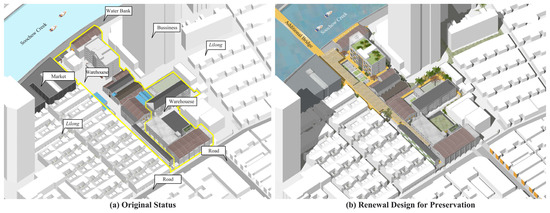
Figure 14.
Design scheme for historical warehouse beside Soochow Creek.
5.4. Establishment of Inclusive Waterfront Business Cluster
The most significant planning issue turned out to be how to attract as many people as possible through the district while mitigating the potential congestion that could arise from the real estate development’s occupants and the necessary services. The primary development objective is to establish a high-quality environmental infrastructure and attract innovative businesses, such as headquarters economy, financial services, and high-tech companies. In the design phase, a circulation plan was drawn to optimize movement patterns and improve access from waterfront business buildings to the subways, while ensuring smooth traffic flow and pedestrian movement. Moreover, the proposal includes the construction of cultural and creative buildings with excellent service platforms, a strong brand effect, and visible agglomeration effects to foster and grow digital creative industries and to support the development of ‘specialized, new, but inclusive’ small and medium-sized creative enterprises.
6. Discussion
Throughout most of human history, production places have been deeply integrated into citizen’s lives, as the medieval town developed primarily as a center for handicraft production, where the production space, living space, and ecological space existed in harmony. However, since the industrial revolution and shift from handicraft to machine production, manufacturing places have evolved into expanding factory zones that are often separated from residential spaces. As a result of the negative characteristics of mass industry, including severe pollution, we are bound to see a dramatic division between manufacturing, society, and nature. The main goal of new industrial urbanism is to make the social and spatial strategies that support the reintegration of industrial places into the city against the background of the postindustrial era.
Urban waterfronts, particularly in port cities, reflect the evolutionary trajectory of the industrialization process from natural land to booming industrial waterfront, and ultimately, to abandoned brownfield sites. Given the global scale of these conditions, urban design has the potential to regenerate industrial waterfronts and make them more vigorous and resilient. From the view of new industrial urbanism, the landscape could offer a multifold medium for integrating a diverse range of discrete elements relating to manufacturing, society, and space. The working fields of planners will move beyond the void spaces between buildings, roadways, and infrastructure to the entirety of intersections. The design of landscape medium offers a pathway through which the intricacies of the urban system, where the significance of design is paramount, can be explored. Nobody would question the possibility to reclaim the industrial waterfront under contemporary engineering technologies. Nevertheless, a paradigm shift is necessary to view infrastructure design not merely as meeting minimum engineering standards but as capable of triggering sustainable and inclusive urban effects beyond its intended capacity. By highlighting the potential of new industrial urbanism to address these challenges, this study provides a valuable contribution to the literature on urban design.
7. Conclusions
This research investigates how to transform an obsolete manufacturing site into an inclusive urban landscape that promotes societal and spatial sustainability using the design process of the Shanghai Yangpu waterfront as its main research subject. The regeneration proposal outlines four design approaches or working paradigms:
- (1)
- Connect the various breakpoints along the waterfront, factory zones, and other separate infrastructures to create sequential experiences for people.
- (2)
- Heal the ecological wounds of the waterfront caused by industry pollution by adopting resilient approaches to recover the ecosystem of water and soil.
- (3)
- Reinvent new typologies for carrying the collective memory of local industry, whether in architecture or landscape design.
- (4)
- Provide flexible amenities and shared infrastructure based on the industrial site to accommodate social activities for citizens, enhancing the place’s attraction, identity, and growth in the future.
The findings of this research demonstrate that the landscape can provide a multifaceted medium for integrating manufacturing, society, and space elements, suggesting a productive way forward. The regeneration proposal provides a practical inquiry into how to transform the large-scale obsolete manufacturing site into an inclusive urban landscape that supports societal and spatial sustainability. The four design approaches or working paradigms above can be applied to other locations to achieve expected results.
This research has some limitations, such as the specific context of the case study being in Shanghai and the challenges of implementing such complex urban design strategies through expansive landscape surface conditions. Future research could explore the applicability of the four design approaches or working paradigms in other industrial waterfront regeneration cases. Furthermore, more research should focus on the difficulties of integrating such a ‘field’ strategy of landscape restoration and supporting the transformation of industry places into a city’s social and spatial strategies against the backdrop of the postindustrial era.
Author Contributions
Conceptualization, Y.W. and Y.L.; methodology, Y.W.; software, Y.W.; validation, Y.W. and Y.L.; formal analysis, Y.W.; investigation, Y.W.; resources, Y.W.; data curation, Y.W.; writing—original draft preparation, Y.W.; writing—review and editing, Y.W.; visualization, Y.W.; supervision, Y.L.; project administration, Y.W. All authors have read and agreed to the published version of the manuscript.
Funding
This research received no external funding.
Institutional Review Board Statement
Not applicable.
Informed Consent Statement
Not applicable.
Data Availability Statement
The project detail (Yangpu Waterfront) in the article could be found in Architectural Journal No.611(8) published in China. We gratefully thank for the original engineering drawing and data provided by Tongji Architectural Design (Group) Co., Ltd.
Conflicts of Interest
The authors declare no conflict of interest.
References
- Wilkinson, T.J. Water and human settlement in the Balikh Valley, Syria: Investigations from 1992–1995. J. Field Archaeol. 1998, 25, 63–87. [Google Scholar]
- Ballestero, A. The anthropology of water. Annu. Rev. Anthropol. 2019, 48, 405–421. [Google Scholar] [CrossRef]
- Cruikshank, K.; Bouchier, N.B. Blighted areas and obnoxious industries: Constructing environmental inequality on an industrial waterfront, Hamilton, Ontario, 1890–1960. Environ. Hist. 2004, 9, 464–496. [Google Scholar] [CrossRef]
- Bell, D. The Coming of the Post-Industrial Society; Taylor & Francis: Abingdon, UK, 1976; pp. 574–579. [Google Scholar]
- Shatrevich, V.; Strautmane, V. Industrialisation factors in post-industrial society. Entrep. Sustain. Issues 2022, 3, 157. [Google Scholar] [CrossRef] [PubMed]
- Marshall, R. Waterfronts in Post-Industrial Cities; Taylor & Francis: Abingdon, UK, 2004. [Google Scholar]
- Berger, A. Drosscape: Wasting Land Urban America; Princeton Architectural Press: Princeton, NJ, USA, 2006. [Google Scholar]
- Hatuka, T.; Ben-Joseph, E. Industrial urbanism: Typologies, concepts and prospects. Built Environ. 2017, 43, 10–24. [Google Scholar] [CrossRef]
- Moffat, A.; Hutchings, T. Greening Brownfield Land. Sustainable Brownfield Regeneration: Liveable Places From Problem Spaces; Blackwell: Oxford, UK, 2007; pp. 143–171. [Google Scholar]
- Pendlebury, J. Alas Smith and Burns? Conservation in Newcastle upon Tyne city centre 1959–1968. Plan. Perspect. 2001, 16, 115–141. [Google Scholar] [CrossRef]
- Alfrey, J.; Putnam, T. The Industrial Heritage: Managing Resources and Uses; Routledge: London, UK, 2003. [Google Scholar]
- Hatuka, T.; Ben-Joseph, E. New Industrial Urbanism: Designing Places for Production; Taylor & Francis: Abingdon, UK, 2022. [Google Scholar]
- Waldheim, C. Landscape urbanism: A genealogy. Prax. J. Writ. + Build. 2002, 4, 10–17. [Google Scholar]
- McAvin, M.; Meyer, E.K.; Corner, J.; Shirvani, H.; Helphand, K.; Riley, R.B.; Scarfo, R. Landscape architecture and critical inquiry. Landsc. J. 1991, 10, 155–172. [Google Scholar] [CrossRef]
- Frampton, K. Megaform as urban landscape. J. Delta Urban. 2021, 2, 12–23. [Google Scholar]
- Rebernik, N.; Marušić, B.G.; Bahillo, A.; Osaba, E. A 4-dimensional model and combined methodological approach to inclusive urban planning and design for ALL. Sustain. Cities Soc. 2019, 44, 195–214. [Google Scholar] [CrossRef]
- Landman, K. Inclusive public space: Rethinking practices of mitigation, adaptation and transformation. Urban Des. Int. 2020, 25, 211–214. [Google Scholar] [CrossRef]
- Zhang, S. Conservation and adaptive reuse of industrial heritage in Shanghai. Front. Archit. Civ. Eng. China 2007, 1, 481–490. [Google Scholar] [CrossRef]
- Yu, Y.; Li, K.; Shu, S. Preservation and Reuse of Industrial Heritage along the Banks of the Huangpu River in Shanghai. In Proceedings of the 15th TICCIH International Congress, Taipei, Taiwan, 4–9 November 2012. [Google Scholar]
- Kirkwood, N. Manufactured Sites: Rethinking the Post-Industrial Landscape; Taylor & Francis: Abingdon, UK, 2003. [Google Scholar]
- Kaufmann, E. Three Revolutionary Architects, Boullée, Ledoux, and Lequeu. Trans. Am. Philos. Soc. 1952, 42, 431–564. [Google Scholar] [CrossRef]
- Hale, J.D.; Sadler, J. Resilient Ecological Solutions for Urban Regeneration. Eng. Sustain. 2012, 165, 59–68. [Google Scholar] [CrossRef]
- Zhang, M.; Zhang, J.; Qin, S. Media of Landscape—Four Stepped Narrations from the Construction of Rainwater Garden at Yangpu Eaterfront Public Space. Chin. Landsc. Archit. 2021, 37, 49–54. [Google Scholar]
- Vecco, M. Genius loci as a meta-concept. J. Cult. Herit. 2020, 41, 225–231. [Google Scholar] [CrossRef]
- Baglioni, P.; Giorgi, R. Soft and hard nanomaterials for restoration and conservation of cultural heritage. Soft Matter 2006, 2, 293–303. [Google Scholar] [CrossRef]
- Cesare, B. Restauro. Enciclopedia Universale dell’Arte. 1963, 11, 322–332. [Google Scholar]
- Wijesuriya, G. Living heritage. Sharing Conservation Decisions: Current Issue and Future Strategies; ICCROM: Rome, Italy, 2018; pp. 43–56. [Google Scholar]
- Rosetti, I.; Bertrand Cabral, C.; Pereira Roders, A.; Jacobs, M.; Albuquerque, R. Heritage and sustainability: Regulating participation. Sustainability 2022, 14, 1674. [Google Scholar] [CrossRef]
- Gehl, J. Public Spaces for a Changing Public Life; Taylor & Francis: Abingdon, UK, 2007; pp. 23–30. [Google Scholar]
- Liu, Y. Environmental management of Soochow Creek in China from the 1920s–1970s: A historical perspective. J. Environ. Manag. 2022, 304, 114278. [Google Scholar] [CrossRef]
- Xu, Z.; Liao, Z. Retracted: Optimization of Suzhou Creek Rehabilitation Project Stage I: Based on Water Quality Model. Environ. Eng. Sci. 2006, 23, 253–262. [Google Scholar] [CrossRef]
Disclaimer/Publisher’s Note: The statements, opinions and data contained in all publications are solely those of the individual author(s) and contributor(s) and not of MDPI and/or the editor(s). MDPI and/or the editor(s) disclaim responsibility for any injury to people or property resulting from any ideas, methods, instructions or products referred to in the content. |
© 2023 by the authors. Licensee MDPI, Basel, Switzerland. This article is an open access article distributed under the terms and conditions of the Creative Commons Attribution (CC BY) license (https://creativecommons.org/licenses/by/4.0/).

